
 |
|
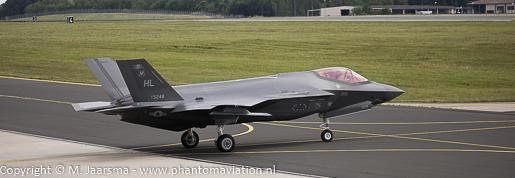 |
| 421st FS inaugural F-35A deployment to Europe |
| Latest update: March 2020 Publication: This article has been published by Scramble magazine September 2019. |
| 388th FW Hill AFB, Utah |
|
The 388th Fighter Wing Hill AFB, Utah became the first operational wing
within the USAF Air Combat Command to operate the Lockheed Martin F-35A
Lightning II. It’s first of 78
assigned aircraft landed at the base in October 2015. Assigned to 388th
FW are three squadrons: 4th FS “Fightin Fuujins”, 34th FS “Rams” and
421st FS “Black Widows”. Since 2007 collocated Air Force Reserve Command
419th FW began flying together with the 388th FW in a Total Force
Integration initiative capitalizing the strengths of both active duty
and reserve forces. As a result the wing and its sole squadron 466th FS
“Diamondbacks” lost its own aircraft. From September 2017 the wing and
its personnel started operating the F-35A. 421st FS is the third squadron to receive the Lightning II after its sister squadrons 4th and 34th FS. The squadron history traces back to April 30, 1943 when it was activated as the 421 Night Fighter Squadron. On February 20, 1947 was deactivated and brought back to live on April 13, 1962. The squadron was redesignated 421 FS on November 1, 1991. It flew the Lockheed Martin F-16C until 2018 when it started its conversion to the Lightning II. The first F-35A for the squadron arrived on December 12, 2018. Lt. Col. Richard Orzechowski accepted command of the squadron in May 2018. Prior to this assignment he served as the F-35A Flight Examiner and Director of Operations of 34 FS (June 2017 – May 2018), Chief of Wing Safety (October 2016 – June 2017). The Colonel transitioned to the F-35A within the 61st FS, 56th FW at Luke AFB Arizona from May until September 2016. |
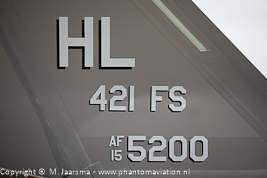 |
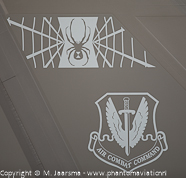 |
| The 421st Fighter Squadron commander aircraft. | 421st FS "Black Widow" markings applied on the tails of the F-35A's. |
| Theater Security Package 2019 |
|
Since 2015 the USAF deploys it squadrons to Europe as part of a Theater
Security Package (TSP) in support of Operation Atlantic Resolve (OAR)
providing security to its Europe NATO allies as well as strengthening
ties and train together. These were normally composed of two combined
Air National Guard F-15C squadrons (2015-2018). In 2019 one Air Force
Reserve Command F-16C squadron was send to Romania. The commander of
USAFE can request additional deployments to augment his security and/or
training needs. In the past this lead to the F-22A Raptor being
deployed. The F-35s isn’t new for Europe as well. The 388th and 419th
Fighter Wings deployed for the first time in 2017 sending eight of their
aircraft to RAF Lakenheath from April 15 until May 7 when the last
aircraft departed back home. During their stay aircraft visited other
countries and conducted training from the base with other nations. The 421st FS, during their deployment designated 421st Expeditionary Fighter Squadron (EFS), received its notification to deploy somewhere in the first months of 2019. They then started to prepare for their journey to and assignments in Europe. On May 23 the squadron arrived at Aviano AB in Italy. Here they participated in exercise Astral Knight together with the Croatian Air Force (Mig-21), Italian Air Force (F-35A, EF-2000), USAF F-16, KC-10A, KC-135R and E-3 AWACS , the USN providing a Arleigh Burke class destroyer and the USAR a Patriot surface-to-air missile system. 421st EFS then relocated its aircraft (12) and personnel (300 of which 26 pilots) to Spangdahlem AB, Germany to continue its assignment for which Lt. Col. Richard C. Orzechowski commented “we will be here for a good portion of the summer.” The squadron commander and his colleague Colonel Michael T. Miles commander of the 388th Maintenance Group took the time to answer questions from the media about the 421st EFS deployment on June 18.
Due to operational security not all questions, mainly related to the remaining training objectives, forward deployments or visit to other countries, could be answered. Upon notification of the imminent TSP deployment the 388th maintenance group prepared the packages to be transported to Europe. These packages consisted of material to operate the aircraft as well as personal items of the deployed personnel. What are the processes set in motion from the notification of the deployment? “It’s a continuation of our day to day training, I know our maintainers team worked very hard to make sure all of the jets were in the best condition possible to make the oceanic crossing and then from pilot perspective we started with after action reports from other squadrons. F-35 squadrons as well as other squadrons that have deployed to Europe specifically so that we could learn from the lesson that they learned firsthand and try to apply those to what we are doing.” What kind of maintenance challenges have been encountered? “During the deployment the squadrons works with the deployable spare package. We energize the supply chain. It’s just working on the communication and then letting the F-35 Joint Program Office, Lockheed Martin and USAF supply system to work prioritizing and actually transfer these parts. This is why we do this, fly these aircraft and let parts reach their life limit and have some sort of malfunction that requires us to energize this supply chain. Being able to identify those supply chain or supply lines in the communication structure is critical and by doing it now we are learning it for the future.” Can you comment on what kind of training you have flown and what kind of missions at Aviano AB during Astral Knight? “We have flown an integrated Air and Missile defensive exercise another term we would use is Defensive counter air (DCA) so we were protecting the coastline if you will from both cruise missiles attacks as well as aircraft.” What was the biggest challenge to fly with 3rd or 4th generation aircraft? “It all goes back to communication so being able to communicate over the radio as well as we have data links so the plan that everyone came up with together to implement in an effective way as possible.” How many F-35s are actually here now at Spangdahlem AB and how many aircraft has the 421st FS received until now? “Right now we have a total of 15, so the 421st EFS brought 12 aircraft one of which is current forward at the Paris Air Show. There were four other F-35s here in Europe with the 34th FS and they brought those aircraft here and we are helping maintain them while they are waiting for tanker support to fly back to the United States.” “The 421st FS does not have our full complement of aircraft, we got our first in November 2018 and we have been getting two or sometimes three a month then. But when we left to come here we had 12 aircraft and we ended up of bringing a combination of 421st aircraft and 4th FS aircraft to round out the 12 we did bring.” Note: The four 34th FS F-35s went to Payerne Air Base, Switzerland to take part in the project AIR 2030 to select a new fighter aircraft for the Swiss Air Force. Currently 4th FS is deployed to U.S. Air Force Central Command theatre of operations at Al Dhafra Air Base in the United Arab Emirates. Do you share your experiences and challenges encountered during this deployment with your colleagues from 4th FS? “We communicate with all F-35 squadrons to be honest with you. It’s a new airframe, and we’re still developing, we’re still learning so whenever we have a lesson learned we try and share that with as many as the F-35 squadrons as possible.” What is your current mission at Spangdahlem? “We’ll be here doing the same things till this point with local training sorties, building partnership and flying with as many partners as we can. I don’t speak about what we will be doing in the future but to this point again we flown in Italy, we flown to Spain, Germany, we flown to Finland and Norway and now also we have one aircraft in France.” Editors note: exercise Astral Knight at Aviano AB, TLP Albacete, Spangdahlem AB, Turku air show and the Paris Air Show at Le Bourget). We have connected with the Italians and Norwegians. It will allow us to operate together we have already streamlined some of the processes.” What was the main purpose of the visit to Turku air show? “We went predominately for the air show following the air show they did fly with some admin / PA perspective. Afterwards the aircraft went to Norway.” Why it’s still necessary to do all these exercises? “I will go back to what I said earlier, It’s critical to train together and communicate with one another and practice deploying these aircraft in that joint and coalition environment so that when we ever needed to do that for real we have worked out the things that inevitable present themselves.” |
| Hill AFB |
|
Currently Hill AFB runway is under construction. The 34 FS is conducting
its operations from Mountain Home AFB, Idaho. Both
34th
FS and 421st EFS will return to Hill AFB from sometime in late July or
early August. 4th EFS will return to Hill AFB at the end of their
deployment rotation. Until its return to the USA the 421st EFS will continue to operate from Spangdahlem AB and looked forward to the training opportunity. “We worked to share the F-35 with as many people as possible and it’s a really great way to educate people and share our wonderful squadron” Lt. Col Orzechowski concluded the meeting with the media. The author would like to thank Col. Miles and Lt. Col. Orzechowski as well as the 52nd FW PAO staff for their hospitability and time. |
| Photo gallery 421st (E)FS at Spangdahlem Air Base. |
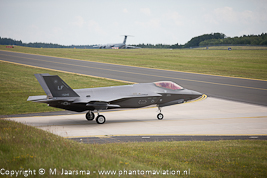 |
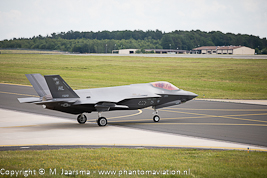 |
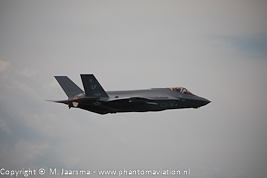 |
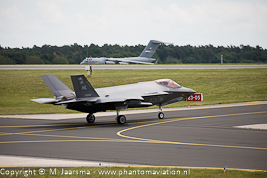 |
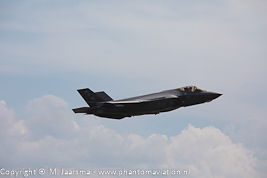 |
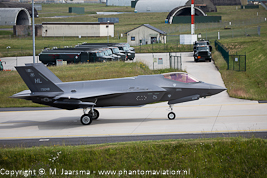 |
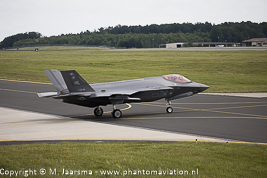 |
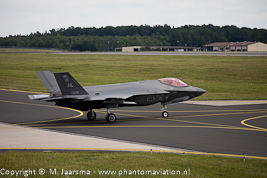 |
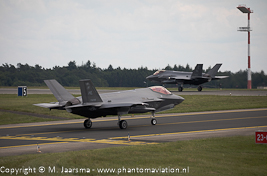 |
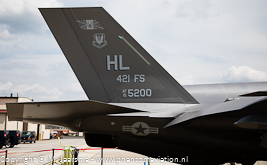 |
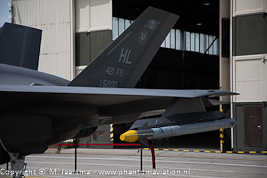 |
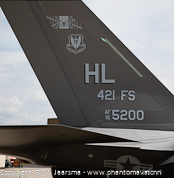 |
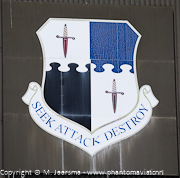 |
|
|